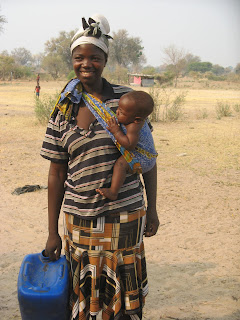 | ||||
|
 |
Jonas has been busy while we were away and has whipped up potato pancakes and golden syrup for lunch, delish! A few of us spend some time writing our diaries in the open sided, restaurant overhanging the river. The camp dog is dozing quietly beside me when he suddenly starts barking at something below us in the river. I rush to have a look and spot a young crocodile right below the deck. Later in the afternoon we board a flat bottomed boat to travel up river to visit a village. Our guide, Christopher, is a tall, slender, elegant Namibian with a head of dangling plaits. He is an enthusiastic bird watcher and, like all the African guides we have met, an ardent conservationist. It is a leisurely one hour cruise to the village, once again dodging hippo along the way. We pass local fishermen,children playing on the river banks and washing strewn along the bushes to dry.
 |
 |
 |
Everyone we speak to is friendly modest, polite and most welcoming. The third compound we visit is large and immaculately clean. Two women are dancing to music on the radio. This is not for our benefit, they stop as soon as they see us. One of the women is very tall and tells us that her husband is in the Namibian army and away from home most of the time. His job has made them wealthy, comparatively speaking, in the village. Their house is built from concrete block and at least three times the size of the other houses She is very proud of her new front door, so proud that it has been installed with the plastic wrapping still in place. She tells us that years ago she had worked for an English doctor and writes his name in the sand in the hope that we may know him. Her friend is a tiny smiley, neat woman, from what is known as the bush men tribe. She also proudly shows us her home.
 |
 |
The whole time we are in the village we see only one man and he appears to be drunk. All the other men are either away working or tending livestock or fishing. The people are desperately poor and many of the children have infections and scabies. We see one little girl aged about four lying in her brother's arms. She appears to be very ill. Her brother is only about six himself but is so tender towards her.
 |
 |
We pick our way back across the paddock to the boat passing a dog which is in a ghastly condition, possibly with cancer. It is a horrible sight. We cruise back down the river as the sun sets and turns the water pink, hippos surfacing all around. It is a serene and magical journey back to camp but our minds are full of what we have seen in the village. The visit has been sobering and humbling. It is worth noting here that life expectancy in Namibia is only 51 for women and 49 for men. With a population of only two and a quarter million there are 200,000 infected with AIDS, the highest rate of infection in Africa. 17% of children have lost at least one parent to AIDS. The government is working very hard to educate the population and turn the AIDS statistics around but it will take some time before real progress is made. We are pleased, at least, that our visit to the village was not only educational for us but financially beneficial to the villagers. After dinner Hils, Gary and I go up to the bar but don't feel like drinking so just sit chatting and soaking up the ambiance. The gardens are tropical and softly lit lanterns are placed here and there amongst small groups chatting, their conversation punctuated by the grunts of hippos.
 |
 |
Photos: Our group ready for the mokoro trip, (2) I look a bit uncertain. Well there are hippos and crocs in the river!, (3) My oarsman, (4) Goats in the litter strewn paddock next to the village, (5) The village day care centre. The baby is only 4 weeks old, (6) Adorable Kovango baby, (7) Tall village woman, around 5 foot. Note the plastic wrapping still on her door, (8) Her tiny friend about 4foot 6, from the bush man tribe, (9) The women prepare meat to dry as biltong. The little boy on the right is nursing his sick sister,
(10) Village children, (11) Off to collect water from the river, (12) Kovango Village

No comments:
Post a Comment